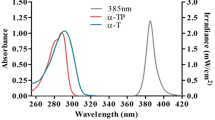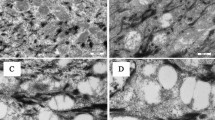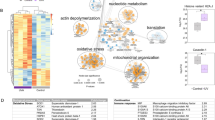Abstract
Epigallocatechin-3-gallate (EGCG), the major constituent of green tea, possesses significant anti-inflammatory and cancer chemopreventive properties. Studies have shown the photochemopreventive effects of green tea and EGCG in cell culture, animal models, and human skin. The molecular mechanism(s) of photochemopreventive effects of EGCG are incompletely understood. We recently showed that EGCG treatment of the normal human epidermal keratinocytes (NHEK) inhibits ultraviolet (UV)B-mediated activation of the mitogen-activated protein kinase (MAPK) pathway. In this study, we evaluated the effect of EGCG on UVB-mediated modulation of the nuclear factor kappa B (NF-κB) pathway, which is known to play a critical role in a variety of physiological functions and is involved in inflammation and development of cancer. Immunoblot analysis demonstrated that the treatment of NHEK with EGCG (10–40 μ M) for 24 h resulted in a significant inhibition of UVB (40 mJ/cm2)-mediated degradation and phosphorylation of IκBα and activation of IKKα, in a dose-dependent manner. UVB-mediated degradation and phosphorylation of IκBα and activation of IKKα was also observed in a time-dependent protocol (15 and 30 min, 1, 2, 3, 6, 12 h post-UVB exposure). Employing immunoblot analysis, enzyme-linked immunosorbent assay, and gel shift assay, we demonstrate that EGCG treatment of the cells resulted in a significant dose- and time-dependent inhibition of UVB-mediated activation and nuclear translocation of a NF-κB/p65. Our data suggest that EGCG protects against the adverse effects of UV radiation via modulations in NF-κB pathway, and provide a molecular basis for the photochemopreventive effect of EGCG.
This is a preview of subscription content, access via your institution
Access options
Subscribe to this journal
Receive 50 print issues and online access
$259.00 per year
only $5.18 per issue
Buy this article
- Purchase on Springer Link
- Instant access to full article PDF
Prices may be subject to local taxes which are calculated during checkout







Similar content being viewed by others
References
Afaq F, Adhami VM, Ahmad N and Mukhtar H . (2002). Front. Biosci., 7, d784–d792.
Afaq F and Mukhtar H . (2001). J. Photochem. Photobiol. B., 63, 61–69.
Ahmad N, Gupta S and Mukhtar H . (2000). Arch. Biochem. Biophys., 376, 338–346.
Ahmad N and Mukhtar H . (2001). Skin Pharmacol. Appl. Skin Physiol., 14, 69–76.
Ames BN . (1983). Science, 221, 1256–1264.
Ananthaswamy HN, Loughlin SM, Cox P, Evans RL, Ullrich SE and Kripke ML . (1997). Nat. Med., 3, 510–514.
Baeuerle PA and Baltimore D . (1988). Science, 242, 540–546.
Baeuerle PA and Baltimore D . (1996). Cell, 87, 13–20.
Baldwin AS . (1996). Annu. Rev. Immunol., 14, 649–683.
Block G . (1993). J. Natl. Cancer Inst., 85, 846–848.
Breuer-McHam J, Simpson E, Dougherty I, Bonkobara M, Ariizumi K, Lewis DE, Dawson DB, Duvic M and Cruz Jr PD (2001). Photochem. Photobiol., 74, 805–810.
Burren RC, Scaletta B, Frenk E, Panizzon RG and Applegate LA . (1998). Int. J. Cancer, 76, 201–206.
Chen N, Ma W, Huang C and Dong Z . (1999). J. Biol. Chem., 274, 15389–15394.
DeGruijl FR . (1999). Eur. J. Cancer, 35, 2003–2009.
Devary Y, Rosette C, DiDonato JA and Karin M . (1993). Science, 261, 1442–1445.
Eller MS, Maeda T, Magnoni C, Atwal D and Gilchrest BA . (1997). Proc. Natl. Acad. Sci. USA, 94, 12627–12632.
Elmets CA, Singh D, Tubesing K, Matsui M, Katiyar SK and Mukhtar H . (2001). J. Am. Acad. Dermatol., 44, 425–432.
Fisher GJ, Datta SC, Talwar HS, Wang ZQ, Varani J, Kang S and Voorhees JJ . (1996). Nature, 379, 335–339.
Garg A and Aggarwal BB . (2002). Leukemia, 16, 1053–1068.
Ghosh S, May MJ and Kopp EB . (1998). Annu. Rev. Immunol., 16, 225–260.
Gilchrest BA, Park HY, Eller MS and Yaar M . (1996). Photochem. Photobiol., 63, 1–10.
Goihman-Yahr M . (1996). Clin. Dermatol., 14, 153–160.
Greenlee RT, Murray T, Bolden S and Wigo PA . (2000). CA Cancer J. Clin., 50, 7–33.
Griffiths HR, Mistry P, Herbert KE and Lunce J . (1998). Crit. Rev. Clin. Lab. Sci., 35, 189–237.
Haas AF, Wong JW, Iwahashi CK, Halliwell B, Cross CE and Davis PA . (1998). Free Radic. Biol. Med., 25, 998–1005.
Helenius M, Makelainen L and Salminen A . (1999). Exp. Cell Res., 248, 194–202.
Hong JT, Kim EJ, Ahn KS, Jung KM, Yun YP, Park YK and Lee SH . (2001). Mol. Carcinog., 31, 152–160.
Ikeda M, Hirose Y, Miyoshi K and Kodama H . (2002). J. Dermatol. Sci., 28, 159–170.
Iordanov M, Bender K, Ade T, Schmid W, Sachsenmaier C, Engel K, Gaestel M, Rahmsdorf HJ and Herrlich P . (1997). EMBO J., 16, 1009–1022.
Katiyar SK, Afaq F, Azizuddin K and Mukhtar H . (2001a). Toxicol. Appl. Pharmacol., 176, 110–117.
Katiyar SK, Afaq F, Perez A and Mukhtar H . (2001b). Carcinogenesis, 22, 287–294.
Katiyar SK, Korman NJ, Mukhtar H and Agarwal R . (1997a). J. Natl. Cancer Inst., 89, 556–566.
Katiyar SK, Mohan RR, Agarwal R and Mukhtar H . (1997b). Carcinogenesis, 18, 497–502.
Katiyar SK, Mukhtar H . (2001). J. Leukoc. Biol., 69, 719–726.
Katiyar SK, Perez A and Mukhtar H . (2000). Clin. Cancer Res., 6, 3864–3869.
Kaufman CK and Fuchs E . (2000). J. Cell Biol., 149, 999–1004.
Kim J, Hwang JS, Cho YK, Han Y, Jeon YJ and Yang KH . (2001). Skin Pharmacol. Appl. Skin Physiol., 14, 11–19.
Kligman LH, Akin FJ and Kligman AM . (1980). J. Am. Acad. Dermatol., 3, 30–35.
Knebel A, Rahmsdorf HJ and Herrlich P . (1996). EMBO J., 15, 5314–5325.
Kripke ML, Cox PA, Lass LG and Yarosh DB . (1992). Proc. Natl. Acad. Sci. USA, 89, 7516–7520.
Lefort K, Rouault JP, Tondereau L, Magaud JP and Dore JF . (2001). Oncogene, 20, 7375–7385.
Legrand-Poels S, Schoonbroodt S, Matroule JY and Piette J . (1998). J. Photochem. Photobiol. B., 45, 1–8.
Lu YP, Lou YR, Li XH, Xie JG, Brash D, Huang MT and Conney AH . (2000). Cancer Res., 60, 4785–4791.
Majumdar S, Lamothe B and Aggarwal BB . (2002). J. Immunol., 168, 2644–2651.
Maniatis T . (1997). Science, 278, 818–819.
Morita A, Werfel T, Stege H, Ahrens C, Karmann K, Grewe M, Grether-Bech S, Ruzicka T, Kapp A, Klotz LO, Sies H and Krutmann JJ . (1997). Exp. Med., 186, 1763–1768.
Mukhtar H and Elmets CA . (1996). Photochem. Photobiol., 63, 356–357.
Naylor MF . (1997). Arch. Dermatol., 133, 373–375.
Nomura M, Kaji A, He Z, Ma WY, Miyamoto K, Yang CS and Dong Z . (2001). J. Biol. Chem., 276, 46624–46631.
Nomura M, Ma W, Chen N, Bode AM and Dong Z . (2000). Carcinogenesis, 21, 1885–1890.
Okabe S, Ochiai Y, Aida M, Park K, Kim SJ, Nomura T, Suganuma M and Fujiki H . (1999). Jpn. J. Cancer Res., 90, 733–739.
Pfundt R, van Vlijmen-Willems I, Bergers M, Wingens M, Cloin W and Schalkwijk J . (2001). J. Pathol., 193, 248–255.
Rice-Evans C . (1999). Proc. Soc. Exp. Biol. Med., 220, 262–266.
Rosette C and Karin M . (1996). Science, 247, 1194–1197.
Saliou C, Kitazawa M, McLaughlin L, Yang JK, Tetsuka T, Iwasaki K, Cillard J, Okamoto T and Packer L . (1999). Free Radic. Biol. Med., 26, 174–183.
Scharffetter-kochanek K, Wlaschek M, Brenneisen P, Schauen M, Bladschun R and Wenk J . (1997). Biol. Chem., 378, 1247–1257.
Schreck R, Rieber P and Baeuerle PA . (1991). EMBO J., 10, 2247–2258.
Stadtman ER . (1992). Science, 257, 1220–1224.
Stancovski I and Baltimore D . (1997). Cell, 91, 299–302.
Thanos AM and Maniatis T . (1995). Cell, 80, 529–532.
Vile GF, Tanew-Ilitschew A and Tyrrell RM . (1995). Photochem. Photobiol., 62, 463–468.
Vink AA, Moodycliffe AM, Shreedhar V, Ullrich SE, Roza L, Yarosh DB and Kripke ML . (1997). Proc. Natl. Acad. Sci. USA., 94, 5255–5260.
Yamazaki S, Muta T and Takeshige K . (2001). J. Biol. Chem., 276, 27657–27662.
Yang F, de Villiers WJ, McClain CJ and Varlilek GW . (1998). J. Nutr., 128, 2334–2340.
Author information
Authors and Affiliations
Corresponding author
Rights and permissions
About this article
Cite this article
Afaq, F., Adhami, V., Ahmad, N. et al. Inhibition of ultraviolet B-mediated activation of nuclear factor κB in normal human epidermal keratinocytes by green tea Constituent (-)-epigallocatechin-3-gallate. Oncogene 22, 1035–1044 (2003). https://doi.org/10.1038/sj.onc.1206206
Received:
Revised:
Accepted:
Published:
Issue Date:
DOI: https://doi.org/10.1038/sj.onc.1206206
Keywords
This article is cited by
-
(-)-Epigallocatechin-3-gallate inhibits nasopharyngeal cancer stem cell self-renewal and migration and reverses the epithelial–mesenchymal transition via NF-κB p65 inactivation
Tumor Biology (2015)
-
Epigallocatechin gallate attenuates fibrosis, oxidative stress, and inflammation in non-alcoholic fatty liver disease rat model through TGF/SMAD, PI3 K/Akt/FoxO1, and NF-kappa B pathways
European Journal of Nutrition (2014)



